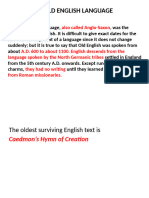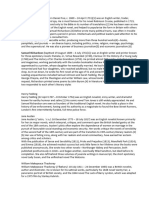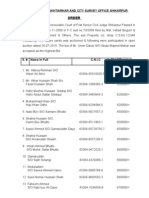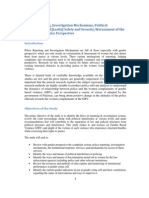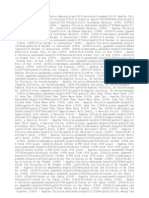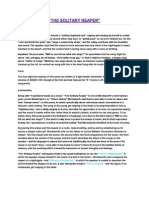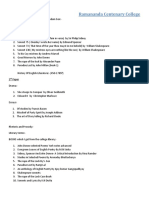(Canterburské Povídky) - Chaucer Was Deeply Influenced by The Italian Renaissance Novellas of
(Canterburské Povídky) - Chaucer Was Deeply Influenced by The Italian Renaissance Novellas of
Uploaded by
Shafqat HussainCopyright:
Available Formats
(Canterburské Povídky) - Chaucer Was Deeply Influenced by The Italian Renaissance Novellas of
(Canterburské Povídky) - Chaucer Was Deeply Influenced by The Italian Renaissance Novellas of
Uploaded by
Shafqat HussainOriginal Description:
Original Title
Copyright
Available Formats
Share this document
Did you find this document useful?
Is this content inappropriate?
Copyright:
Available Formats
(Canterburské Povídky) - Chaucer Was Deeply Influenced by The Italian Renaissance Novellas of
(Canterburské Povídky) - Chaucer Was Deeply Influenced by The Italian Renaissance Novellas of
Uploaded by
Shafqat HussainCopyright:
Available Formats
English Literature
Old English literature The earliest form of English literature developed after the settlement of the Saxons and other Germanic tribes in England after the withdrawal of the Romans. The most famous work in Old English is the epic poem Beowulf, which appeared probably in the 7th century. It tells how King Hrothgar built a great hall for his warriors. But a monster, Grendel, visited it for a period of twelve years, murdering the men asleep there. Beowulf, nephew of a king from Sweden, heard of this, crossed the sea to the hall, and in a struggle tore off Grendels arm. After having killed Grendel, Beowulf was attacked by Grendels mother and he killed her too. When he returned home, he became king. The oldest surviving text in English is Cdmon's Hymn. Caedmon, a monk and religious poet, is the earliest known English author. Venerable Bede (Ctihodn Beda), a Benedictine monk, was a historian, philosopher and scientist of the early 8th century. His works were written in Latin. He is called the father of English history. The Anglo-Saxon Chronicle, a collection of nine manuscripts in Old English, created in the late 9the century, narrates the history of Anglo-Saxons. Medieval literature in England In the later medieval period a new form of English now known as Middle English evolved. This is the earliest form which is comprehensible to modern readers and listeners. The most significant Middle English author was the poet Geoffrey Chaucer (1340 1400) , the father of English poetry, who was active in the late 14th century. His main work was The Canterbury Tales (Canterbursk povdky). Chaucer was deeply influenced by the Italian Renaissance novellas of Giovanni Boccacio, the author of Decameron. The tales are framed by a story of a group of thirty pilgrims heading to Canterbury. Among the pilgrims there are the Knight, the Monk, the Prioress, the Carpenter, the Miller, the Pardoner or the Wife of Bat all social levels are presented here. The pilgrims agree to tell two tales each on their way to Canterbury and two on the way back. Unfortunatelly, only twenty-three tales were written and the book stayed unfinished. Early Modern English literature
In the later 16th century English poetry was characterised by elaboration of language and allusion to classical myths. The most important poets of this era include Edmund Spenser and Sir Philip Sidney. The most important literary achievements of the English Renaissance were in drama. William Shakespeare (1564 1616), born in Stratford upon Avon, wrote over 35 plays in several genres, including tragedy, comedy, and historical plays. His most famous plays include Romeo and Juliet, Hamlet, Othello, Macbeth, King Lear, and many others. He also wrote love poetry in the form of sonnets. Other leading playwrights of the time included Ben Jonson and Christopher Marlowe, a very talented playwright, who was killed at the age of 29.
The major poets of the 17th century included John Donne and the other metaphysical poets, and John Milton, the author of the religious epic Paradise Lost (Ztracen rj). The early 18th century is known as the Augustan Age of English literature. The poetry of the time was highly formal, an example can be the works of Alexander Pope. The English novel developed during the 18th century, partly in response to an expansion of the middle-class reading public. One of the major early works in this genre was Robinson Crusoe by Daniel Defoe, a story of a shipwrecked man on a deserted island. Major novelists of the middle and later part of the century included Henry Fielding, Laurence Sterne, and Jonathan Swift with his satirical novel Gullivers Travels (Gulliverovy cesty).. Novelist Jane Austen was a good observer of peoples characters. She wrote about middle-class country aristocrats shose most urgent preoccupation is to find a suitable partner and to marry. Her most mature work Pride and Prejudice (Pcha a pedsudek) was filmed. Romanticism William Wordsworth and Samuel Taylor Coleridge brought emotionalism to English literature, with a new concentration on the individual and the common man. They explored natureand were called the Lake Poets. William Blake was a very original and creative poet, painter and printmaker. Scottish nationalist poet Robert Burns collected and adapted the folk songs of Scotland. George Gordon Byron, the author of Childe Harolds Pilgrimage (Childe Haroldova pou), Don Juan and others, was the son of a nobleman. His life was full of revolt against the society, religion and monarchy. Mary Shelley, who was married to poet Percy Byshe Shelley, wrote Frankenstein, an inspiration for modern horror stories. The 19th century novel Walter Scott's novel-writing career started in 1814 with Waverley, often called the first historical novel, and was followed by Ivanhoe. He wrote abou Scottish history and was the highest earning and most popular author up to that time. Charles Dickens emerged on the literary scene in the 1830s. Dickens wrote about London life and the struggles of the poor, but in a good-humoured fashion which was accessible to readers of all classes. His early works such as The Pickwick Papers (Kronika Pickwickova klubu) are masterpieces of comedy. Later his works became darker. His most famous novels are probably Oliver Twist, Great Expectations (Nadjn vyhldky) and David Copperfield. It was in the Victorian era (1837-1901) that the novel became the leading form of literature in English. The best known works of the era include the emotionally powerful works of the Bront sisters and the satire Vanity Fair by William Makepeace Thackeray. Charlotte Bront is famous for hel novel Jane Eyre and her sister Emily Bront is the author of Wuthering Heights (Na Vtrn hrce).
An interest in rural matters and the changing social and economic situation of the countryside may be seen in the novels of Thomas Hardy. He depicted the tragedy of the common man in his struggle with the elements and the social system (Far from the Madding Crowd Daleko od hlucho davu). Literature for children was published during the Victorian period, some of which has become globally well-known, such as the work of Lewis Carroll (Alices Adventures in Wonderland Alenka v i div). Robert Louis Stevenson's short novel Strange Case of Dr Jekyll and Mr Hyde (Podivuhodnn ppad dr. Jekylla a pana Hyda) (1886) depicts the dual personality of a kind and intelligent physician who turns into a psychopathic monster after imbibing a drug. His Kidnapped (nos) is a fast-paced historical novel set in the aftermath of the '45 Jacobite Rising, and Treasure Island (Ostrov poklad) is the classic pirate adventure. Oscar Wilde is famous not only for his beautiful fairy tales, for example (The Happy Prince (astn princ), The Nightingale and the Rose (Slavk a re). The Canterville Ghost (Straidlo cantervillsk ) is a story of a ghost, driven mad by the tricks of naughty twins. It is released by the tears of a fair maiden and dies happily ever after. The Picture of Dorian Gray shows the ugly side of the supernatural.
Victorian poets Leading poetic figures of the Victorian era included Alfred Tennyson, Robert Browning, and his wife, Elizabeth Barrett Browning. The poetry of this period was heavily influenced by the Romantics. Most of Brownings poems were in the form of dramatic monologues. Nonsense verse by Edward Lear is regarded as a precursor of surrealism. He popularized limericks, short five-line poems, witty and humorous, sometimes even obscene. English language literature since 1900
The major lyric poet of the first decades of the 20th century was Thomas Hardy, who concentrated on poetry after the the public had refused his last novel, Jude the Obscure (Neblah Juda), for its frank treatment of sex. The most widely popular writer of the early years of the 20th century was probably Rudyard Kipling, a highly versatile writer of novels, short stories and poems, often based on his experiences in British India. Kipling was closely associated with imperialism and this has damaged his reputation in more recent times. He is best known for his work The Jungle Book (Kniha dungl). From around 1910, the Modernist Movement began to influence English literature. The major poets of this period included the American-born T. S. Eliot, Ezra Pound, and the Irishman William Butler Yeats. Free verse and other stylistic innovations came to the forefront in this era. Important novelists between the two World Wars included the Irish writer James Joyce, David Herbert Lawrence, and Virginia Woolf. Joyce's complex works included Ulysses (Odysseus), an interpretation of the Odyssey set in Dublin, and culminated in the famously obscure Finnegans Wake (Plaky nad Finneganem). This novel has not been translated into Czech yet (except short extracts), since it is extremely difficult to read and
almost impossible to translate. Lawrence wrote with understanding about the social life of the lower and middle classes, and the personal life of those who could not adapt to the social norms of his time. He attempted to explore human emotions more deeply than his contemporaries and wrote quite openly about sexual issues in Lady Chatterley's Lover (Milenec Lady Chatterleyov). Virginia Woolf was an influential feminist, and a major stylistic innovator. Her novels included To the Lighthouse (K majku), Mrs Dalloway (Pan Dallowayov), and The Waves (Vlny). She committed suicide. One of the most significant English writers of this period was George Orwell. Orwell's works are considered among the most important social and political commentaries of the 20th century. He dealt with issues such as poverty, totalitary regimes (in Nineteen Eighty-Four) and colonialism. William Golding came to literary success with his novel Lord of the Flies (Pn much), a story of a group of boys on a deserted island. In contrast to Jules Vernes novel Two Years Vacation (Dva roky przdnin), the boys do not create a harmonious society, they fight and even kill. Angry Young Men were a group of young writers named after John Osborne's iconic play Look Back in Anger (Ohldni se v hnvu). Kingsley Amis describes, in his novel Lucky Jim (astn Jim), a young man who tries to oppose the world round him. In the 1950s, the bleak absurdist play Waiting for Godot (ekn na Godota), by the Irish playwright Samuel Beckett profoundly affected British drama. The Theatre of the Absurd influenced playwrights of the later decades of the 20th century, including Harold Pinter, whose works are often characterized by menace or claustrophobia, and Tom Stoppard (of Czech origin).
You might also like
- MODG Poetry List KDocument1 pageMODG Poetry List Kbwalsh1No ratings yet
- A Brief History of English Literature NotesDocument15 pagesA Brief History of English Literature NotesThe CSS Point80% (46)
- Victorian LiteratureDocument26 pagesVictorian LiteratureLoana Lulu100% (1)
- A Brief History of English Literature PDFDocument19 pagesA Brief History of English Literature PDFZulqarnain Khan100% (1)
- Europe Central Vollmann PDFDocument2 pagesEurope Central Vollmann PDFMary0% (2)
- Good Novel OpeningsDocument1 pageGood Novel Openingsapi-250945637No ratings yet
- History of British Literature HandoutDocument4 pagesHistory of British Literature HandoutSofia PonceNo ratings yet
- Victorian Period WritersDocument102 pagesVictorian Period WriterslalalaNo ratings yet
- Literature Complete SummaryDocument95 pagesLiterature Complete SummarySinead SineadNo ratings yet
- Introduction To LiteratureDocument2 pagesIntroduction To LiteratureMarini DondoNo ratings yet
- Edwardian PeriodDocument14 pagesEdwardian PeriodJoshee Mgdn BalucanNo ratings yet
- British and Irish LiteratureDocument2 pagesBritish and Irish LiteratureVojta PodliskaNo ratings yet
- English Literature 21st LiteratureDocument3 pagesEnglish Literature 21st LiteratureJ.C. CallanganNo ratings yet
- Type of Victorian Novels: Herbert George "H. G." Wells (21 September 1866Document6 pagesType of Victorian Novels: Herbert George "H. G." Wells (21 September 1866Edu MorenoNo ratings yet
- History of English LiteratureDocument3 pagesHistory of English Literaturechristopher sloanNo ratings yet
- Representative Authors and Texts From Europe and North AmericaDocument69 pagesRepresentative Authors and Texts From Europe and North AmericaTjhay Noche100% (1)
- Trends in 20th Century English LiteratureDocument6 pagesTrends in 20th Century English LiteratureKulnaz Kaur GondaraNo ratings yet
- Famous Writers and Their Works in 18th CenturyDocument4 pagesFamous Writers and Their Works in 18th CenturyFrancis EstebanNo ratings yet
- History of English Literature, Chapter 1 Old EnglishDocument50 pagesHistory of English Literature, Chapter 1 Old EnglishAli HassanNo ratings yet
- P B ShellyDocument60 pagesP B ShellyStudy GuideNo ratings yet
- History of English Modern LiteratureDocument9 pagesHistory of English Modern LiteratureM Hisyam AlfalaqNo ratings yet
- Tokoh Penulis Era EdwardianDocument4 pagesTokoh Penulis Era EdwardianIce PrincessNo ratings yet
- A Brief History of English LiteratureDocument9 pagesA Brief History of English LiteratureJavedkhan PathanNo ratings yet
- Outline of English LiteratureDocument44 pagesOutline of English LiteraturepelobikkNo ratings yet
- The Victorian AgeDocument4 pagesThe Victorian AgeMathilde BrèsNo ratings yet
- English Literature Is The Literature Which Is: (Citation Needed)Document2 pagesEnglish Literature Is The Literature Which Is: (Citation Needed)Lizamhel MendozaNo ratings yet
- Edwardian PeriodDocument19 pagesEdwardian PeriodMelbert Quidor0% (1)
- Edwardian PeriodDocument19 pagesEdwardian Periodmc mcdonalds100% (1)
- Spoorthy Sharone Net/Jrf English Literature: Search FacebookDocument5 pagesSpoorthy Sharone Net/Jrf English Literature: Search FacebookMuhammad UsmanNo ratings yet
- English Literature: The Victorian AgeDocument7 pagesEnglish Literature: The Victorian AgeNadica1954100% (1)
- 20TH Century LiteratureDocument7 pages20TH Century LiteratureAna Maria RaduNo ratings yet
- English Romanticism: Romantic PoetryDocument58 pagesEnglish Romanticism: Romantic PoetryKhushnood Ali100% (1)
- British LiteratureDocument21 pagesBritish LiteratureBoboNo ratings yet
- The Authors of Modern AgeDocument7 pagesThe Authors of Modern AgeFaisalabadi AwamNo ratings yet
- American Literature ReyesDocument32 pagesAmerican Literature ReyesBernardinoNo ratings yet
- Top 20 Worlds Most Famous Writers and Books (Investigacion)Document8 pagesTop 20 Worlds Most Famous Writers and Books (Investigacion)Lizzy OrdoñezNo ratings yet
- British LiteratureDocument5 pagesBritish Literatureniangmadiop541No ratings yet
- Age of JohnsonDocument15 pagesAge of Johnsonnkumarrs100% (1)
- English Speaking Countries: List of Significant Authors: 1. BeowulfDocument5 pagesEnglish Speaking Countries: List of Significant Authors: 1. BeowulfDunas SvetlanaNo ratings yet
- Let's Review!: English LiteratureDocument11 pagesLet's Review!: English LiteratureAziladna SircNo ratings yet
- 1st Month Authors and Writers 3rd WeekDocument9 pages1st Month Authors and Writers 3rd WeekMelany Esther Feliz V�squezNo ratings yet
- 3RD PART (Literary Genres)Document7 pages3RD PART (Literary Genres)GABRIEL CABANSAGNo ratings yet
- 10 Foreign Writers With DescriptionDocument11 pages10 Foreign Writers With DescriptionMyleenx PrlntlngshopNo ratings yet
- Famous WritersDocument21 pagesFamous Writersjayrjing101508gmailcNo ratings yet
- A School Project On Rise of The NovelDocument3 pagesA School Project On Rise of The Novelsanjaybantu100% (1)
- MN Bxojf'ps XDocument4 pagesMN Bxojf'ps Xamina28092002No ratings yet
- Literary Genres. HandoutsDocument4 pagesLiterary Genres. HandoutsRovz GC BinNo ratings yet
- 20TH-CENTURY LITERATURE - Post-World War I Fiction, Modern Poetry, Fiction After World War II, Modern Poetry, Modern Drama ReferatDocument4 pages20TH-CENTURY LITERATURE - Post-World War I Fiction, Modern Poetry, Fiction After World War II, Modern Poetry, Modern Drama ReferatBhaskar MukherjeeNo ratings yet
- History of British LiteratureDocument7 pagesHistory of British Literatureestefany pomacanchari rojasNo ratings yet
- 21stPWLiterature - English LiteratureDocument5 pages21stPWLiterature - English LiteraturebadrodenashimaNo ratings yet
- Timeline of The Literary WritersDocument3 pagesTimeline of The Literary WritersAisha KhanNo ratings yet
- Literary Genres From Different TraditionsDocument7 pagesLiterary Genres From Different TraditionsGerrylyn BalanagNo ratings yet
- The Development of English Literature (Summary)Document4 pagesThe Development of English Literature (Summary)Geetanjali JoshiNo ratings yet
- Văn Học Anh Mỹ Bài 1-2Document21 pagesVăn Học Anh Mỹ Bài 1-2Nguyễn Thu UyênNo ratings yet
- Unit 2 Poetry Summary - 1717202543569186Document18 pagesUnit 2 Poetry Summary - 1717202543569186amandeepkahlon98No ratings yet
- British Literature 2011Document10 pagesBritish Literature 2011Julian A. MurilloNo ratings yet
- A Brief History of English LiteratureDocument13 pagesA Brief History of English LiteratureŇěwťóň ŠháhNo ratings yet
- 21 STDocument15 pages21 STLovely Rocel RubioNo ratings yet
- One novel...a lot of Novels: brief history of the novel in English languageFrom EverandOne novel...a lot of Novels: brief history of the novel in English languageNo ratings yet
- Home History of Science History of Astronomy Books Subscriptions ContactDocument2 pagesHome History of Science History of Astronomy Books Subscriptions ContactShafqat HussainNo ratings yet
- About Radio DramaDocument4 pagesAbout Radio DramaShafqat HussainNo ratings yet
- About ScienceDocument2 pagesAbout ScienceShafqat HussainNo ratings yet
- Graduate Assessment Test (Gat - 2013-II) GAT General: Search Result For The KeywordDocument1 pageGraduate Assessment Test (Gat - 2013-II) GAT General: Search Result For The KeywordShafqat HussainNo ratings yet
- Curriculum Vitae: Personal ProfileDocument2 pagesCurriculum Vitae: Personal ProfileShafqat HussainNo ratings yet
- About ResearchDocument3 pagesAbout ResearchShafqat HussainNo ratings yet
- Sahara SportsDocument2 pagesSahara SportsShafqat HussainNo ratings yet
- Borrowing Loans: Switching Styles and Extreme Forms ofDocument1 pageBorrowing Loans: Switching Styles and Extreme Forms ofShafqat HussainNo ratings yet
- Curriculum Vitae: Personal ProfileDocument2 pagesCurriculum Vitae: Personal ProfileShafqat HussainNo ratings yet
- Literature SindhiDocument34 pagesLiterature SindhiShafqat HussainNo ratings yet
- Order: Office of The Mukhtiarkar and City Survey Office ShikarpurDocument9 pagesOrder: Office of The Mukhtiarkar and City Survey Office ShikarpurShafqat HussainNo ratings yet
- Australia, Pakistan, New Zealand, Sri Lanka, Zimbabwe, Canada, Kenya. India, South Africa, England, West Indies, Bangladesh, Ireland, NetherlandsDocument2 pagesAustralia, Pakistan, New Zealand, Sri Lanka, Zimbabwe, Canada, Kenya. India, South Africa, England, West Indies, Bangladesh, Ireland, NetherlandsShafqat HussainNo ratings yet
- Abstract Sheet: Quantity Rate Unit AmountDocument1 pageAbstract Sheet: Quantity Rate Unit AmountShafqat HussainNo ratings yet
- AghaDocument1 pageAghaShafqat HussainNo ratings yet
- Interview With SIDocument7 pagesInterview With SIShafqat HussainNo ratings yet
- Regards Tahir AfzalDocument5 pagesRegards Tahir AfzalShafqat HussainNo ratings yet
- Javed RajparDocument1 pageJaved RajparShafqat HussainNo ratings yet
- A Tale of Two CitiesDocument3 pagesA Tale of Two CitiesdrvofixxxNo ratings yet
- New FormalismDocument3 pagesNew FormalismDevidas Krishnan100% (1)
- 100 Greatest NovelsDocument3 pages100 Greatest NovelsEne Maria-Claudia100% (1)
- ND RD: The Wreck The Roofwalker (Optional)Document1 pageND RD: The Wreck The Roofwalker (Optional)faust K.No ratings yet
- Literary Genres Lesson in Grade 11Document3 pagesLiterary Genres Lesson in Grade 11Mark Ace RodriguezNo ratings yet
- Ezra Pound Hugh Selwyn Mauberley PDFDocument2 pagesEzra Pound Hugh Selwyn Mauberley PDFChadNo ratings yet
- Poems - I Wandered Lonely As A CloudDocument3 pagesPoems - I Wandered Lonely As A CloudHerda HerdaHydraNo ratings yet
- Book Sale FIAR, Misc. Living Books, & Literature AprilDocument8 pagesBook Sale FIAR, Misc. Living Books, & Literature AprilgreenebaltsNo ratings yet
- ( (Demonoid - Me) ) - 91 Agatha Christie Bks (EPUB MOBI) Dates Series Meta Complete For Calibre 11340883Document82 pages( (Demonoid - Me) ) - 91 Agatha Christie Bks (EPUB MOBI) Dates Series Meta Complete For Calibre 11340883ja2936No ratings yet
- College Recommended ReadingDocument3 pagesCollege Recommended ReadingalexNo ratings yet
- The Howl Obscenity TrialDocument2 pagesThe Howl Obscenity TrialMarcusFelsmanNo ratings yet
- Jorie_GrahamDocument8 pagesJorie_Grahamnoonan.oster.ravenNo ratings yet
- Philip LarkinDocument1 pagePhilip LarkinJohn MartinezNo ratings yet
- Character Traits WorksheetDocument5 pagesCharacter Traits Worksheetpatricia_verdino0% (1)
- Fair Stood The Wind For France PDFDocument2 pagesFair Stood The Wind For France PDFArlyn0% (1)
- Pulitzer Prize For FictionDocument4 pagesPulitzer Prize For Fictionsvntemp100% (1)
- Agatha Christie: ReadingDocument2 pagesAgatha Christie: ReadingGrigala Brothers ChanelNo ratings yet
- Top 100 Books - The ObserversDocument9 pagesTop 100 Books - The ObserversWilma Esteban100% (1)
- Ap Suggested Reading ListDocument6 pagesAp Suggested Reading Listapi-290988513No ratings yet
- English LiteratureDocument4 pagesEnglish LiteratureRahul KapoorNo ratings yet
- The Solitary ReaperDocument1 pageThe Solitary ReaperShammas ShahidNo ratings yet
- Books That Everyone Should Read at Least OnceDocument10 pagesBooks That Everyone Should Read at Least OnceelitetitanNo ratings yet
- Recommended 6th Grade ReadingDocument3 pagesRecommended 6th Grade Readingapi-64419505No ratings yet
- The BrookeDocument3 pagesThe Brookeapcc1No ratings yet
- 40 Influential Black Authors 1 2Document14 pages40 Influential Black Authors 1 2PrincessLiya AbundantlyBlessed Mitchell0% (1)
- MA GU Syllabus PDFDocument61 pagesMA GU Syllabus PDFnavalgajjarNo ratings yet
- Ramananda Centenary Colleg1Document2 pagesRamananda Centenary Colleg1Arindam Sen100% (1)























